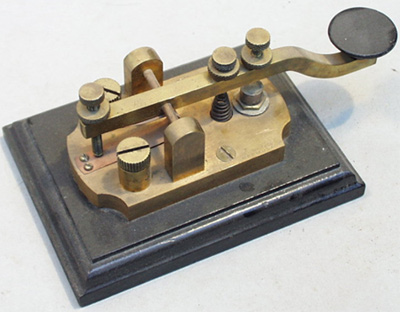Early Communication Technology - Morse Code and Ethernet
We tend to think of digital communication as a new idea but in 1844 a man called Samuel Morse sent a message 37 miles from Washington D.C. to Baltimore, using his new invention ‘The Telegraph’. This may seem a far cry from today's computer networks but the principles remain the same.
Morse code is type of binary system which uses dots and dashes in different sequences to represent letters and numbers. Modern data networks use 1s and 0s to achieve the same result. The big difference is that while the telegraph operators of the mid 19th Century could perhaps transmit 4 or 5 dots and dashes per second, computers now communicate at speeds of up to 1 Giga bit, or to put it another way, 1,000,000,000 separate 1s and 0s every second.

Figure 1. Morse Code device used to transmit '0' and '1'
Although the telegraph and the teletypewriter were the forerunners of data communications, it has only been in the last 35 years that things have really started to speed up. This was borne out of the necessity for computers to communicate at ever ncreasing speeds and has driven the development of faster and faster networking equipment, higher and higher specification cables and connecting hardware.
Development Of New Network Technology
Ethernet was developed in the mid 1970's by the Xerox Corporation at its Palo Alto Research Centre (PARC) in California and in 1979 DEC and Intel joined forces with Xerox to standardize the Ethernet system for everyone to use. The first specification by the three companies, called the 'Ethernet Blue Book', was released in 1980, it was also known as the 'DIX standard' after their initials.
It was a 10 Mega bits per second system (10Mbps, = 10 million 1s and 0s per second) and used a large coaxial backbone cable running throughout the building, with smaller coax cables tapped off at 2.5m intervals to connect to the workstations. The large coax, which was usually yellow, became known as 'Thick Ethernet' or 10Base5 - the '10' refers to the speed (10Mbps), the 'Base' because it is a base band system (base band uses all of its bandwidth for each transmission, as opposed to broad band which splits the bandwidth into separate channels to use concurrently) and the '5' is short for the system's maximum cable length, in this case 500m.
The Institute of Electrical and Electronic Engineers (IEEE) released the official Ethernet standard in 1983 called the IEEE 802.3 after the name of the working group responsible for its development and, in 1985, version 2 (IEEE 802.3a) was released. This second version is commonly known as 'Thin Ethernet' or 10Base2; in this case the maximum length is 185m even though the '2' suggest that it should be 200m.
Other popular Ethernet standards developed and widely used include:
Since 1983, various standard have been introduced because of the increased bandwidth requirements, so far we are up to the 40Gigabit rate!
Wi-Fi Key Generator
Follow Firewall.cx
Cisco Password Crack
Decrypt Cisco Type-7 Passwords on the fly!














